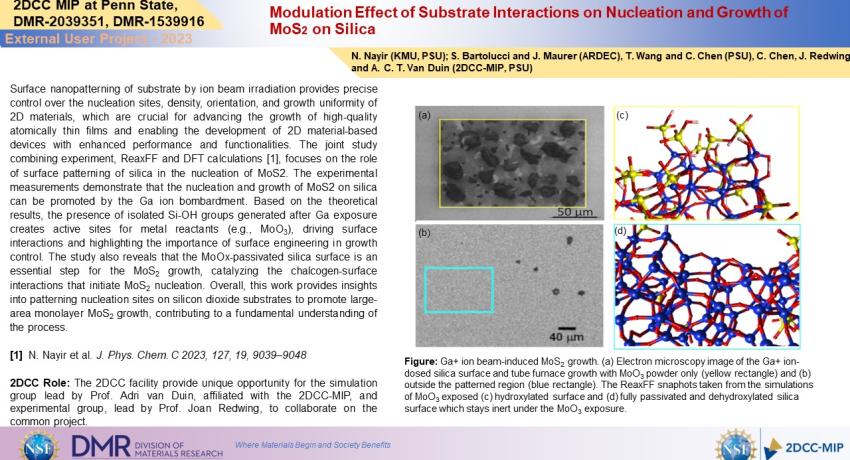Surface nanopatterning of substrate by ion beam irradiation provides precise control over the nucleation sites, density, orientation, and growth uniformity of 2D materials, which are crucial for advancing the growth of high-quality atomically thin films and enabling the development of 2D material-based devices with enhanced performance and functionalities. The joint study combining experiment, ReaxFF and DFT calculations [1], focuses on the role of surface patterning of silica in the nucleation of MoS2. The experimental measurements demonstrate that the nucleation and growth of MoS2 on silica can be promoted by the Ga ion bombardment. Based on the theoretical results, the presence of isolated Si-OH groups generated after Ga exposure creates active sites for metal reactants (e.g., MoO3), driving surface interactions and highlighting the importance of surface engineering in growth control. The study also reveals that the MoOx-passivated silica surface is an essential step for the MoS2 growth, catalyzing the chalcogen-surface interactions that initiate MoS2 nucleation. Overall, this work provides insights into patterning nucleation sites on silicon dioxide substrates to promote large-area monolayer MoS2 growth, contributing to a fundamental understanding of the process.
2DCC Role: The 2DCC facility provide unique opportunity for the simulation group lead by Prof. Adri van Duin, affiliated with the 2DCC-MIP, and experimental group, lead by Prof. Joan Redwing, to collaborate on the common project.
What Has Been Achieved: In this study, to accurately model the phenomenon observed in experiments, we developed a ReaxFF potential, which is capable of simulating the CVD growth of MoS2 from MoO3 and S2 or H2S precursors and other chemical reactions. Through this study, this force field has been made available for Materials Science community.
Importance of the Achievement: Through this study for the first time, we developed a new reactive force field that can enable large scale simulations of CVD growth of MoS2 on silica with/without hydroxylation. This research provides a fundamental understanding of patterning nucleation sites on a silicon dioxide substrate and can assist in promoting the spatial growth of large-area monolayer MoS2.
2DCC Role: The 2DCC facility provides a unique opportunity for the simulation group led by Prof. Adri van Duin, affiliated with the 2DCC-MIP, and the experimental group, led by Prof. Joan Redwing, to collaborate on the common project.
Unique Feature(s) of the MIP that Enabled this Achievement: 2DCC-MIP provides a unique in-house expertise on ReaxFF force field development and large-scale molecular dynamics simulations because Prof. Van Duin, who is affiliated with the 2DCC-MIP, is the inventor of the ReaxFF method.
Publication: N. Nayir, S. Bartolucci, T. Wang, C. Chen, J. Maurer, J. M. Redwing, and A. C. T. van Duin, “Modulation Effect of Substrate Interactions on Nucleation and Growth of MoS2 on Silica”, J. Phys. Chem. C, 127, 19, 9039–9048 (2023). https://doi.org/10.1021/acs.jpcc.3c01010
Acknowledgements: The work was financially supported by the National Science Foundation (NSF) through the Pennsylvania State University 2D Crystal Consortium−Materials Innovation Platform (2DCC-MIP) under NSF cooperative agreements DMR-1539916 and DMR-2039351.
